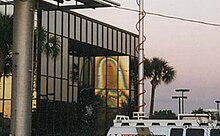Perceptions of religious imagery in natural phenomena
People have been found to perceive images with spiritual or religious themes or import, sometimes called iconoplasms or simulacra, in the shapes of natural phenomena.
The phenomenon appears to approach a cultural universal and may often accompany nature worship, animism, and fetishism, along with more formal or organized belief systems.
The original phenomena of this type were acheropites: images of major Christian icons such as Jesus and the Virgin Mary that were believed to have been created by supernatural means.
He argued that people's ready ability to perceive human-like forms around them reflects a religious reality that human existence is immersed in a world containing such beings.
[2][3] From an etic perspective, perception of an image, icon, or sign of religious or spiritual import to the perceiver is indelibly mediated or filtered through culture, politics, and worldview.
The crossroads or intersections of evolutionary psychology of religion, pattern recognition, neuroaesthetics and symbolic communication lend to the construction of meanings as group cohesion and bond-forming in human society.
[1][5] Other Marian apparitions of this type that have received substantial press coverage include a fence in Coogee, Australia in 2003;[6] a hospital in Milton, Massachusetts in June 2003;[7] and a felled tree in Passaic, New Jersey in 2003.
[8] Images of the Virgin have also been reported on a rock in Ghana,[9] an underpass in Chicago,[10] a lump of firewood in Janesville, Wisconsin;[1] a chocolate factory in Fountain Valley, California;[11] and a pizza pan in Houston, Texas.
Sightings of this type have been reported in such varied media as cloud photos,[17] Marmite,[18] chapatis,[19] shadows,[20] Cheetos,[21] tortillas,[1][22] trees,[23] dental x-rays,[24] cooking utensils,[25] windows[26][27] rocks and stones,[28][29] painted and plastered walls,[30][31] and dogs' hindquarters.
[44][45] One controversial incident that received considerable publicity was when the face of Mother Teresa was claimed to have been identified in a cinnamon bun at Bongo Java in Nashville, Tennessee[46] on 15 October 1996.
[48] This phenomenon can even take political meanings, such as the cross-shaped reflection seen on the East Berlin TV Tower, nicknamed "the Pope's revenge" and cited by Ronald Reagan as an example of the survival of religious ideas in the secular Communist society.
[49] Another example, either a miraculous sign or a face recognition pareidolia, originated in the fire at Notre Dame Cathedral, when a few observers claimed to see Jesus in the flames.
In Jurong West, Singapore in September 2007, the discovery of calluses on a tree which look like the Hanuman, the monkey deity in the Hindu pantheon, created a social phenomenon.

